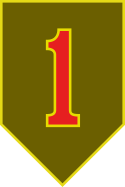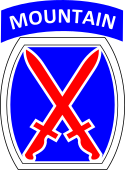172nd Infantry Brigade (Vereinigte Staaten)

Die 172nd Infantry Brigade (deutsch 172. US-Infanteriebrigade) (Blackhawk Brigade) war ein selbständiges Infantry Brigade Combat Team (IBCT) der US Army. Die Brigade war Teil der United States Army Europe und eine von nur drei aktiven, selbständigen Kampfbrigaden der Army. Sie unterstand somit keinem Verband auf Divisionsebene, sondern direkt dem V. US-Korps in Wiesbaden.[1]
Geschichte


Der Verband wurde erstmals im August 1917 als Teil der National Army aufgestellt und der 86th Infantry Division unterstellt. Die Brigade erreichte Frankreich im September 1918, eine Teilnahme an Kampfhandlungen im Ersten Weltkrieg ist jedoch nicht überliefert. In der Zwischenkriegszeit war die Brigade weiterhin Teil der 86. Division, somit als Teil der Reserve eine Ausbildungseinheit, und in Springfield, Illinois, stationiert. 1939 wurden alle Brigaden des US-Heeres aufgelöst und nur die Stabskompanien (Headquarters and Headquarters Company, HHC) blieben bestehen. Die HHC der 172. Brigade wurde 1942 zu einem Aufklärungszug innerhalb der 86. Infanteriedivision umgebildet und erlebte mit dieser die letzten Kriegstage in Europa, als die Division die 8. US-Infanteriedivision ablöste, allerdings ausschließlich in defensiver Stellung. Als die Division schließlich nach kurzzeitiger Rückkehr in die USA im September 1945 in den Pazifik verlegt wurde, war die Kapitulation Japans bereits unterzeichnet und das Ende des Krieges damit besiegelt.
In der Folgezeit wurde die Brigade 1963 erneut aufgestellt und als selbständiger Verband der Regular Army zugeteilt, bevor sie im April 1986 in Fort Richardson, Alaska vorläufig deaktiviert wurde, wobei die bisher unterstellten Bataillone der 6. US-Infanteriedivision eingegliedert wurden. An den Kriegen in Korea und Vietnam nahm der Verband nicht teil.
Am 17. April 1998 wurde die Brigade – als erste der erneut formierten selbständigen Brigaden der US Army – als 172nd Infantry Brigade (Separate) in Fort Wainwright, Alaska aktiviert. Dem Verband wurden ein Luftlandebataillon sowie zwei Infanteriebataillone der 2. Infanteriedivision unterstellt. Als „theater defense brigade“ sollte er als Eingreiftruppe für Alaska sowie den Nordpazifik bereitstehen.
Im Rahmen der Umsetzung der Heeresreform von 1997 wurde die 172nd Infantry Brigade zu einem Stryker Brigade Combat Team (SBCT) umgewandelt. Die Brigade erhielt mehr als 300 Stryker-Radpanzer und einige Unmanned Aerial Vehicles als fliegende Aufklärungskomponente. Diese Umstrukturierung sollte der Brigade mehr Mobilität verschaffen und den Logistikaufwand reduzieren. Die Transformation wurde am 16. Oktober 2003 abgeschlossen und die Brigade war damit die dritte Stryker-Brigade der US Army. Im Frühjahr 2005 änderte der Kommandeur das Motto der Brigade von Snow Hawks in Arctic Wolves.
Operation Iraqi Freedom 2005/06
Im August 2005 wurde die Brigade zur Unterstützung der Operation Iraqi Freedom nach Mosul in den Irak verlegt. Der Einsatz, der ursprünglich am 27. Juli 2006 beendet sein sollte, dauerte schließlich bis November 2006. Während dieser Zeit verlegte die Brigade nach Bagdad. Mit einer Einsatzdauer von 16 Monaten war dies der längste Einsatz einer Einheit der US Army seit dem Vietnamkrieg. In Anerkennung dessen verlieh General George W. Casey der Einheit den Valorous Unit Award, die zweithöchste Einheitenauszeichnung der Army.[2][3] Während des Einsatzes wurden 26 Soldaten getötet und 350 Soldaten der Brigade verletzt. Nach der Rückkehr vom verlängerten Einsatz aus Bagdad wurde am 14. Dezember 2006 das 172nd Stryker Brigade Combat Team offiziell umbenannt in 1st Stryker Brigade Combat Team, 25th Infantry Division.[4]
Reaktivierung
Nach dieser Quasideaktivierung im Dezember 2006 wurde die Brigade am 16. März 2008 als 172nd Infantry Brigade erneut in Schweinfurt reaktiviert, wo sie die 2. Brigade der 1. US-Infanteriedivision in Deutschland ablöste. Ausrüstung und Fahrzeuge sowie Personal wurden dabei beibehalten. Das Motto der Brigade lautete seither „Blackhawks“. Der Verband wurde bis Ende 2008 zum Großteil nach Grafenwöhr verlegt.[5]
Operation Iraqi Freedom 2008/09
Ende November 2008 wurde die Brigade als Teil der Multi-National Force Iraq zunächst nach Kuwait, später in den Irak verlegt.[6] Ende Dezember 2008 übernahm die Brigade schließlich das Kommando über die Forward Operating Base Kalsu südlich von Bagdad und löste damit das 4. Brigade Combat Team (Vanguard) der 3. US-Infanteriedivision ab. Die Blackhawk-Brigade war verantwortlich für ein Gebiet mit der Fläche der Schweiz. Ihre Aufgabe lag vor allem im Wiederaufbau und der Unterstützung der lokalen Regierungsstellen. Die Dauer des Einsatzes war auf zwölf Monate festgesetzt. Im Herbst 2009 wurde die Brigade schrittweise nach Deutschland zurückverlegt.[7][8]
Abzug aus Europa und Auflösung
Die Brigade sollte im Jahr 2012 in die USA zurückkehren und als 7th Brigade Combat Team, 1. US-Panzerdivision auf der White Sands Missile Range, New Mexico neu aufgestellt werden. Als Teil der Sparbemühungen im Verteidigungshaushalt wurde die Brigade im Oktober 2013 jedoch aufgelöst.[9]
Organisation

Die Brigade umfasste zum 16. März 2008 sechs Bataillone sowie drei selbständige Kompanien.
- Headquarters and Headquarters Company, 172nd Infantry Brigade (Grafenwöhr)
- 2nd Battalion, 28th Infantry (Grafenwöhr)
- 1st Battalion, 2nd Infantry (Schweinfurt/Grafenwöhr)
- 3rd Battalion, 66th Armor (Grafenwöhr)
- 9th Engineer Battalion (Schweinfurt)
- 1st Battalion, 77th Field Artillery (Schweinfurt/Grafenwöhr)
- 172nd Support Battalion (Schweinfurt/Grafenwöhr)
- Troop E, 5th Cavalry (Grafenwöhr)
- 57th Signal Company (Grafenwöhr)
- 504th Military Intelligence Company (Grafenwöhr)
Nach der Rückkehr aus dem Irak sollten alle in Schweinfurt verbliebenen Truppenteile nach und nach Richtung Grafenwöhr verlegt werden.[10]
Weblinks
- Lineage And Honors auf history.army.mil (englisch)
Einzelnachweise
- ↑ United States Army, V Corps, Organization ( vom 3. Januar 2010 im Internet Archive), Homepage des V. US-Korps
- ↑ 172nd Stryker Brigade Legacy to Live on as Unit ‘Reflags,’ Gets New Commanders, American Forces Press Service, 15. Dezember 2006
- ↑ Army Prepares for Fall 2008 Active-duty Rotations in Iraq, army.mil/news release, 28. Mai 2008.
- ↑ 172nd Reflagged. Abgerufen am 24. Mai 2014 (englisch).
- ↑ TENANT UNITS as of 2 Feb 2009 ( vom 7. Oktober 2009 im Internet Archive) (PDF; 130 kB), Plans, Analysis and Integration Office, US Army Garrison Grafenwöhr. Abgerufen am 7. April 2024.
- ↑ 172nd Infantry Brigade ships tanks, gear for deployment, Stars and Stripes, 28. Oktober 2008
- ↑ 172nd Infantry takes over in Iraqi area. In: The Stars and Stripes. 27. Dezember 2008, abgerufen am 19. August 2019 (englisch).
- ↑ Vanguard Brigade transfers authority to the 172nd Infantry Brigade ( des vom 9. Januar 2016 im Internet Archive) Info: Der Archivlink wurde automatisch eingesetzt und noch nicht geprüft. Bitte prüfe Original- und Archivlink gemäß Anleitung und entferne dann diesen Hinweis., Task Force Mountain, 27. Dezember 2008
- ↑ DOD announces plans to adjust posture of land forces in Europe. (PDF; 43 Kb) In: media.defense.gov. U.S. Army Europe Public Affairs, 16. Februar 2012, abgerufen am 19. August 2019 (englisch).
- ↑ News Release. (PDF; 429 Kb) Army Announces Next Steps in USAREUR Transformation. In: media.defense.gov. HQ U.S. ARMY EUROPE & 7TH ARMY - Office of the Chief of Public Affairs, Heidelberg, 6. März 2008, abgerufen am 19. August 2019 (englisch).
Auf dieser Seite verwendete Medien
4th Infantry Division shoulder insignia :
I created this work during the course of my official duties. As a United States Army soldier, it is considered the work of the United States Federal Government, and as such is in the public domain. -- Steven Williamson (HiB2Bornot2B) - talk 15:49, 26 July 2007 (UTC)
Autor/Urheber: Diese W3C-unbestimmte Vektorgrafik wurde mit Inkscape erstellt ., Lizenz: CC BY-SA 3.0
The shoulder sleeve insignia of 2d Stryker Cavalry Regiment
The official logo of the United States Army (USA). It can be seen on the official United States Army website in September 2001.
US 1st Cavalry Division
SHOULDER SLEEVE INSIGNIA
- Description: On a yellow triangular Norman shield with rounded corners 5 1/4 inches in height overall, a black diagonal stripe extending over the shield from upper left to lower right and in the upper right a black horse's head cut off diagonally at the neck all within a 1/8 inch green border.
- Symbolism: Yellow, the traditional cavalry color, and the horse's head refer to the division's original cavalry structure. Black, symbolic of iron, alludes to the transition to tanks and armor. The black diagonal stripe represents a sword baldric and is a mark of military honor; it also implies movement "up the field" and thus symbolizes aggressive elan and attack. The one diagonal bend, as well as the one horse's head, also alludes to the division's numerical designation.
- Background: The shoulder sleeve insignia was originally approved January 3, 1921 with several variations in colors of the bend and horse's head to reflect the subordinate elements of the division. The current design was authorized for wear by all subordinate elements of the division on December 11, 1934 and previous authorization for the variations was cancelled.
3rd Infantry Division Shoulder Sleeve Insignia
1st Infantry Division Combat Service Identification Badge
172nd Infantry Brigade Shoulder Sleeve Insignia
75th Ranger Regiment Distinctive Unit Insignia
25th Infantry Division Shoulder Sleeve Insignia
The 11th Armored Cavalry Regiment Shoulder Patch
The official insignia for the 11th Airborne Division. The Army will re-designate U.S. Army Alaska and two Alaska-based brigade combat teams this summer as the 11th Airborne Division Headquarters and the 1st and 2nd Brigade Combat Teams, 11th Airborne Division. This re-designation is an outgrowth of the Army’s January 2021 Arctic Strategy and sets us on the path towards a force that is more appropriately manned, trained, and equipped for the Arctic environment.
Shoulder Sleeve Insignia of the United States Army Special Operations Command.
Description: On a red stylized spearhead with a 1/8 inch red border, 3 1/2 inches in height and 2 inches in width overall, a black Fairbairn-Sykes dagger. A black tab with "AIRBORNE" in red letters is attached above the insignia.
Symbolism: The stylized spearhead alludes to the shoulder sleeve insignia worn by the lst Special Service Forces and signifies the heritage and traditions that the US Army Special Operations Command will perpetuate. The unsheathed black dagger symbolizes total military preparedness and has long been associated with Army special operation forces. The airborne tab designates the command's airborne status.
Background: The shoulder sleeve insignia was approved effective 1 December 1989.Shoulder Patch of 173rd Airborne Brigade
3rd Armored Regiment Shoulder Sleeve Insignia
1st Special Forces Operational Detachment Delta Unit Patch
Autor/Urheber: Noclador, Lizenz: CC BY-SA 3.0
Structure 172nd US Infantry Brigade.
US Army 1st Armored Division Shoulder Sleeve Insignia
- Upon a five pointed white star whose points lie in the circumference of an imaginary circle 3-1/2 inches (8.89 cm) in diameter a Native American's head with war bonnet in profile, face red, bonnet blue with outline of feathers in blue.
- The star to be superimposed upon a black shield, of dimensions such that the points of the star shall lie at a distance of 1/8 inch (.32 cm) from the perimeter.
Symbolism:
- The star has played an important part in our history from the days of the Colonies to the present time.
- The Native signifies the first and original American.
- These devices were originally established by the division to use as vehicle markings and to identify the vehicles as all American.
Background:
- The shoulder sleeve insignia was originally authorized for the 2d Division on 6 Nov 1918, officially announced by The Adjutant General letter, 21 Jun 1922, amended to correct the description on 7 Nov 1927 and redesignated for the 2d Infantry Division on 1 Aug 1942.
Work of Federal Government
Shoulder sleeve patch of the U.S. 10th Mountain Division The 10th Mountain shoulder patch consists of a white-bordered powder keg. The powder keg is in blue and, superimposed on it are two red bayonets in saltire so as to form the Roman numeral “X”. The bayonets represent the Infantry and the numerical designation of the Division. This is the Shoulder Sleeve Insignia; the Distinctive Unit Insignia can be found at Image:10th Mountain Division-distinctive unit insignia.jpeg.
On a blue powder keg-like background, with a white border, two bayonets in saltire throughout scarlet fimbriated white. The blue background and the bayonets are symbolic of infantry while the position of the bayonets in saltire simulates the numerical designation of the organization.172nd Infantry Brigade Distinctive Unit Insignia
Colonel Jeffrey A. Sinclair und Command Sergeant Major Steven W. McClaflin während der Kommandoübergabe durch das 4. Brigade Combat Team, 3. Infanteriedivision an die 172. Infanteriebrigade am 18. Dezember 2008 in der Forward Operating Base Kalsu























